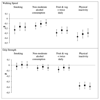Epidemiology of sarcopenia and insight into possible therapeutic targets
- PMID: 28469267
- PMCID: PMC5444517
- DOI: 10.1038/nrrheum.2017.60
Epidemiology of sarcopenia and insight into possible therapeutic targets
Abstract
Musculoskeletal ageing is a major public health concern owing to demographic shifts in the population. Sarcopenia, generally defined as the age-related loss of muscle mass and function, is associated with considerable risk of falls, loss of independence in older adults and hospitalization with poorer health outcomes. This condition is therefore associated with increased morbidity and health care costs. As with bone mass, muscle mass and strength increase during late adolescence and early adulthood, but begin to decline substantially from ∼50 years of age. Sarcopenia is characterized by many features, which include loss of muscle mass, altered muscle composition, infiltration with fat and fibrous tissue and alterations in innervation. A better understanding of these factors might help us to develop strategies that target these effects. To date, however, methodological challenges and controversies regarding how best to define the condition, in addition to uncertainty about what outcome measures to consider, have delayed research into possible therapeutic options. Most pharmacological agents investigated to date are hormonal, although new developments have seen the emergence of agents that target myostatin signalling to increase muscle mass. In this review we consider the current approaching for defining sarcopenia and discuss its epidemiology, pathogenesis, and potential therapeutic opportunities.
Conflict of interest statement
Conflict of Interest: CC has received consultancy, lecture fees and honoraria from AMGEN, GSK, Alliance for Better Bone Health, MSD, Eli Lilly, Pfizer, Novartis, Servier, Medtronic and Roche. SS and EMD declare that they have no conflict of interest.
Figures





References
-
- Cruz-Jentoft AJ, Landi F, Schneider SM, Zuniga C, Arai H, Boirie Y, Chen L-K, Fielding RA, Martin FC, Michel J-P, Sieber C, et al. Prevalence of and interventions for sarcopenia in ageing adults: a systematic review. Report of the International Sarcopenia Initiative (EWGSOP and IWGS) Age Ageing. 2014;43:748–759. doi: 10.1093/ageing/afu115. - DOI - PMC - PubMed
-
- Muscaritoli M, Anker SD, Argilés J, Aversa Z, Bauer JM, Biolo G, Boirie Y, Bosaeus I, Cederholm T, Costelli P, Fearon KC, et al. Consensus definition of sarcopenia, cachexia and pre-cachexia: Joint document elaborated by Special Interest Groups (SIG) “ cachexia-anorexia in chronic wasting diseases” and “ nutrition in geriatrics”. Clin Nutr. 2010;29:154–159. doi: 10.1016/j.clnu.2009.12.004. - DOI - PubMed
-
- Cruz-Jentoft AJ, Baeyens JP, Bauer JM, Boirie Y, Cederholm T, Landi F, Martin FC, Michel J-P, Rolland Y, Schneider SM, Topinkova E, et al. Sarcopenia: European consensus on definition and diagnosis: Report of the European Working Group on Sarcopenia in Older People. Age Ageing. 2010;39:412–423. doi: 10.1093/ageing/afq034. - DOI - PMC - PubMed
Publication types
MeSH terms
Grants and funding
- MC_UP_A620_1015/MRC_/Medical Research Council/United Kingdom
- MC_U147574237/MRC_/Medical Research Council/United Kingdom
- MC_U147574234/MRC_/Medical Research Council/United Kingdom
- MC_UU_12011/2/MRC_/Medical Research Council/United Kingdom
- MC_U147585819/MRC_/Medical Research Council/United Kingdom
- MC_UP_A620_1014/MRC_/Medical Research Council/United Kingdom
- 19583/VAC_/Versus Arthritis/United Kingdom
- MC_UU_12011/1/MRC_/Medical Research Council/United Kingdom
- G0400491/MRC_/Medical Research Council/United Kingdom
- MC_U147585824/MRC_/Medical Research Council/United Kingdom
- MC_U147585827/MRC_/Medical Research Council/United Kingdom
- MC_U147574212/MRC_/Medical Research Council/United Kingdom
LinkOut - more resources
Full Text Sources
Other Literature Sources
Research Materials

